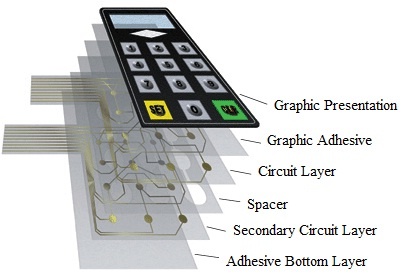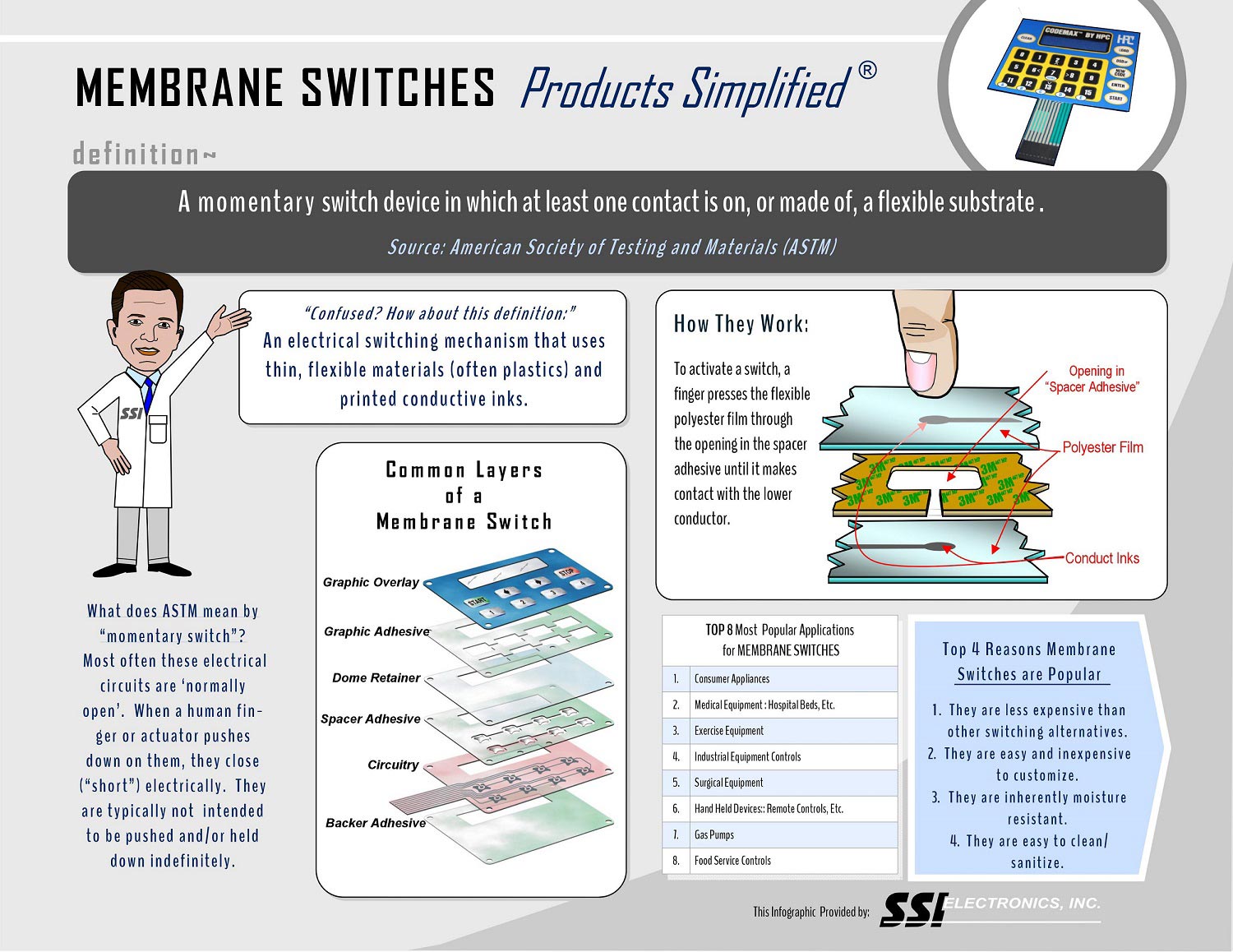Six industries leveraging membrane switch technology
All About Membrane layer Switch: A Comprehensive Overview for Beginners
Membrane layer buttons are necessary elements in modern-day electronic devices, providing a distinct user interface for individual communication - membrane switch. Their layered building, consisting of overlays and conductive traces, offers capability and toughness. Unlike typical mechanical buttons, membrane buttons present a smooth style and customizable choices. Understanding their crucial features and benefits can transform product style. Nevertheless, the details of their application and style considerations warrant more exploration
What Is a Membrane Change?
A membrane switch is a kind of electric button that is composed of a flexible membrane layer layered over a published circuit board. This design enables a sleek and small interface, frequently utilized in different digital tools. Membrane switches are frequently located in customer appliances, clinical devices, and commercial equipment due to their longevity and resistance to ecological factors.The construction usually includes several layers, such as visuals overlays and adhesive backing, which provide tactile feedback and secure the wiring beneath. The procedure of a membrane layer button is launched when stress is related to the surface area, finishing an electrical circuit.These buttons are valued for their versatility, enabling custom designs and printed graphics that cater to specific interface. Their inconspicuous nature decreases space requirements, making them perfect for applications where conventional switches may not fit. In general, membrane buttons supply a useful and visual solution for modern electronic tools.
Trick Parts of Membrane Switches
Membrane layer switches over make up numerous vital components that contribute to their performance and performance. The top layer, called the overlay, provides the user interface and is typically published with icons or graphics. Below the overlay exists a spacer layer, which divides the conductive elements and stops unintended activation. The following important part is the graphic layer, which improves visual appeals and ensures the longevity of the design.Conductive traces, normally made from products like silver or carbon, are printed on the circuit layer. When pressure is used to the overlay, these traces enter get in touch with, completing the circuit. In addition, a support layer offers structural support and can be made from materials such as polyester or polycarbonate. Together, these parts develop a trusted, easy to use user interface suitable for different applications, from home appliances to industrial devices. Recognizing these aspects is essential for anybody interested in membrane layer switch innovation.
How Membrane Switches Job
Comprehending exactly how membrane switches over function is vital for valuing their extensive usage in various tools. A membrane switch operates with a series of layers, including a graphic overlay, spacer, and a circuit layer. When pressure is related to the overlay, it compresses the spacer layer, enabling the circuit layer to make contact and finish an electric circuit. This action sends out a signal to the gadget, prompting an action, such as transforming on a light or activating a function.Membrane changes can be designed with numerous functions, consisting of tactile responses, backlighting, and personalized graphics, improving customer interaction. Their building enables a sealed style, protecting the inner parts from dirt, dampness, and impurities. This resilience makes them appropriate for varied applications, from customer electronic devices to commercial equipment. Overall, the simplicity and effectiveness of membrane layer switches over contribute to their appeal in modern innovation.
Advantages of Membrane Layer Changes Over Mechanical Switches
While mechanical switches have long been a staple in many gadgets, membrane layer changes offer distinctive benefits that make them significantly appealing. One significant advantage is their slim profile, enabling even more portable styles and higher flexibility in product advancement. In addition, membrane layer changes feature an uniform surface, which improves visual charm and streamlines cleansing, making them appropriate for settings where health is critical.Another benefit is their resistance to dust and moisture. Unlike mechanical buttons, which can be jeopardized by environmental factors, membrane layer switches provide a closed user interface that shields against pollutants - membrane switch. Membrane layer buttons normally have a longer life expectancy due to less moving components, resulting in improved durability and reliability.Cost-effectiveness is likewise a notable benefit, as membrane layer buttons can be generated in bulk with lower production prices. These variables integrate to position membrane layer switches as a functional choice to typical mechanical options in various applications
Usual Applications of Membrane Layer Changes
Membrane buttons are widely used in numerous fields, specifically in customer electronic devices and commercial control panels. In customer gadgets, they supply a sleek, easy to use interface, while in commercial setups, they boost resilience and performance. Recognizing these applications highlights the flexibility and usefulness of membrane layer buttons in modern technology.
Customer Electronic Devices Gadgets
As customer electronics proceed to evolve, membrane layer switches have actually come to be a preferred selection for a variety of tools because of their convenience and smooth layout. These buttons are generally found in smart devices, tablet computers, and push-button controls, where room is minimal and aesthetic appeals matter. Their low account and adjustable styles permit makers to produce straightforward interfaces that improve the general user experience. Additionally, membrane layer switches are often used in devices such as microwaves and coffee manufacturers, offering instinctive control options while withstanding moisture and dirt. The resilience and dependability of membrane layer switches over make them ideal for everyday customer items, ensuring longevity and consistent efficiency. On the whole, their integration in consumer electronic devices reflects a blend of capability and modern-day design.
Industrial Control Panels
The applications of membrane layer switches expand beyond customer electronic devices, finding substantial use in commercial control panels. These buttons are favored for their longevity and resistance to harsh settings, making them suitable for making and procedure control settings. They offer a dependable user interface for operators to manage equipment, display procedures, and readjust settings. Membrane layer switches can be tailored to match particular functional needs, right here incorporating attributes like backlighting and tactile comments, enhancing user experience. Their inconspicuous design enables integration right into various equipment, while their ability to endure spills, dirt, and extreme temperature levels guarantees long life. On the whole, membrane buttons add to effective and secure procedure in commercial applications, showing their convenience and efficiency popular settings.
Factors To Consider for Designing Membrane Layer Switches
When making membrane layer switches, choosing the best products is important to assure toughness and performance. Additionally, recognizing layer arrangement techniques can greatly affect the switch's performance and user experience. These considerations play an important function in producing reputable and reliable membrane layer switch styles.
Product Option Significance
Product option plays a vital duty in the design and capability of membrane buttons. The picked materials directly affect the switch's durability, tactile feedback, and overall aesthetic. Key considerations consist of the substratum, which must offer architectural integrity while enabling versatility, and the graphic overlay, which needs to be resistant to put on and environmental elements. Conductive products should guarantee dependable electrical performance, while adhesives must provide strong bonding without endangering the button's procedure. Furthermore, compatibility with manufacturing processes and end-user this page environments is essential; materials need to withstand varying temperature levels, moisture degrees, and chemical direct exposure. Ultimately, proper material choice not only enhances the membrane button's performance however additionally adds to its long life and user fulfillment, making it a vital facet of the style procedure.

Layer Configuration Strategies

Frequently Asked Questions
The Length Of Time Do Membrane Layer Switches Over Typically Last?
Membrane buttons usually have a life try this out expectancy of 1 to 5 million cycles, relying on usage and environmental problems. Factors such as style quality and operating regularity substantially influence their resilience and total efficiency durability.

Can Membrane Changes Be Customized for Specific Designs?
Membrane layer buttons can without a doubt be personalized to suit certain designs, permitting diverse forms, shades, and functionalities. This versatility enables suppliers to tailor these buttons to fulfill special visual and functional requirements efficiently.
What Products Are Used in Membrane Switch Over Construction?
Membrane buttons are usually constructed utilizing materials such as polyester, polycarbonate, and glue layers. These products supply versatility, durability, and resistance to ecological variables, guaranteeing the switches operate efficiently in various applications and conditions.
Are Membrane Layer Changes Waterproof or Resistant to Moisture?
Membrane layer switches can be designed to be moisture-resistant, making use of specialized products and finishings. Nevertheless, their water resistant abilities rely on building and construction high quality and specific applications, making it vital to evaluate demands for excellent performance in various atmospheres.
Exactly How Are Membrane Switches Over Fixed if Damaged?
Repairing broken membrane layer switches typically involves changing the influenced layer or circuit. Service technicians might also apply conductive sticky or use specialized fixing packages, guaranteeing performance is recovered without complete substitute of the whole switch assembly. Unlike traditional mechanical switches, membrane layer buttons present a sleek style and customizable alternatives. A membrane layer button is a type of electrical button that consists of a flexible membrane layer layered over a published circuit board. The operation of a membrane button is started when pressure is applied to the surface, completing an electric circuit.These switches are valued for their adaptability, making it possible for personalized designs and printed graphics that provide to certain user interfaces. While mechanical buttons have long been a staple in numerous devices, membrane layer switches offer distinctive benefits that make them significantly appealing. Membrane layer switches typically have a longer life expectancy due to fewer relocating components, resulting in improved sturdiness and reliability.Cost-effectiveness is also a noteworthy benefit, as membrane layer buttons can be created in bulk with lower manufacturing expenses.